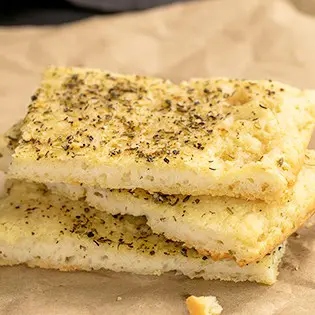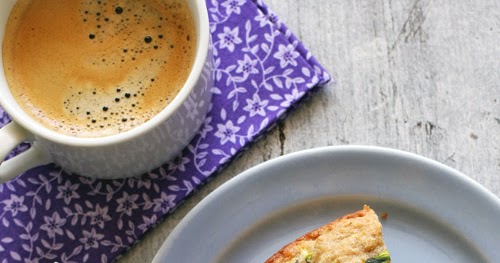Try this gluten free focaccia bread recipe to pair with pasta or eat on its own. This gf Italian herb bread has a crispy, flavorful outside and soft, fluffy inside.

Gluten free herb focaccia that’s crispy on the outside and light and airy on the inside, with that well-developed yeasty flavor and aroma. What’s not to love?

Why you’ll love this recipe
I worked really hard to master this gluten free focaccia recipe, and I promise that it will only take one bite to convince you that it’s the best.
The most important ingredients in the recipe are the gluten free flours — be sure you’ve got the right ones on hand as that’s the only way to recreate my delicious results. (This is the case in most gluten free baking, but it’s especially important when it comes to the tapioca flour here — more on that below.)
Just wait until you see how delicious the results are, though. This bread bakes up nice and crispy on the outside and soft and fluffy on the inside.
This is a wonderful recipe, but keep in mind that it does take a bit of time to prepare from start to finish. It’s not hard, though, because there’s only about 25 minutes of hand-on prep time. The rest is spent letting the dough rise and baking.
Gluten free focaccia bread: key ingredients
- Gluten free flour blend – I say this in most of my gluten free bread recipes, but this is one where I need to really emphasis the importance of using the right gluten free flour. I recommend that you use Better Batter, and I really can’t say what kind of results you’ll see if you try something else.
- Tapioca starch – Another gluten free flour, tapioca starch is an absolute must for this focaccia bread recipe. There is no other flour that can produce the same results, so be sure to pick some up before starting.
- Yeast – I recommend using instant yeast in this gluten free focaccia bread recipe, but you can use active dry yeast with some extra preparation if that’s all you have on hand. You’ll need to use 25{5676e3b156b07d12bd9df9fe13d641a85da396026abde11a1ff2d0afc1b3c015} more active dry yeast than instant, by weight, and you’ll have to hydrate it with some of the liquid from the recipe in advance.
- Warm water – It’s very important that you carefully check the temperature of the water before mixing it with the yeast. If the water is too hot — even by a few degrees — it could kill the delicate yeast.
- Honey – We use honey in the starter to “feed” the yeast and encourage that delicious, yeasty taste.
- Olive oil – You’ll use quite a bit of olive oil in this recipe, so make sure it’s one that you love the flavor of.
- Herbs – You really can’t go wrong with your choice of herbs as a topping. I love using a blend of savory herbs, but you can also go for classic dried rosemary or anything else that interests you.
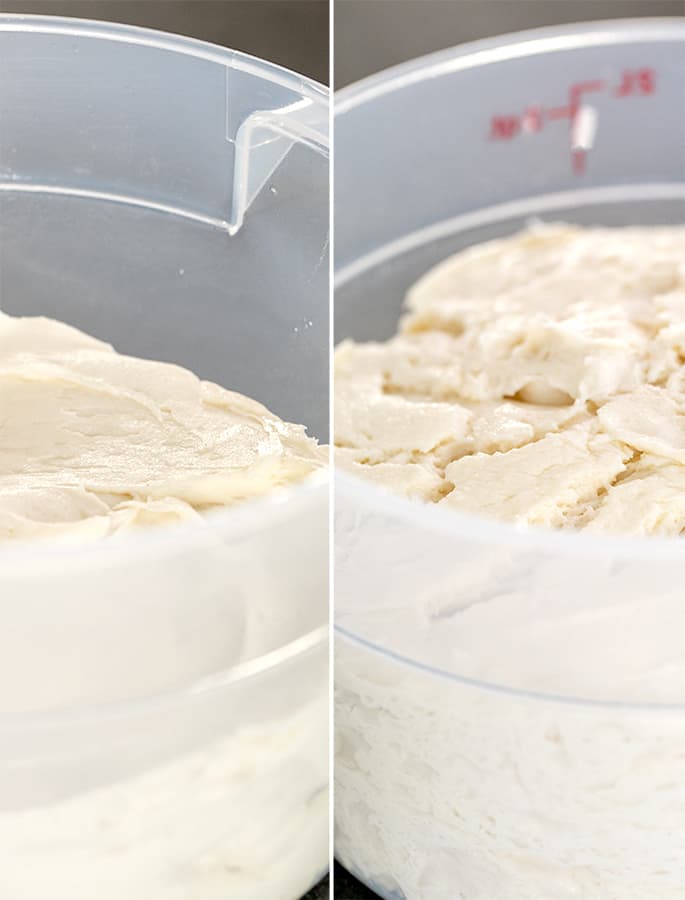
This recipe is worth your (mostly hands-off) time
There is nothing tricky about this focaccia recipe. If you allow me to guide you through it, step by step, and you’ve carved out some time to let it rise, you will be able to make this happen.
Everything is intentional. The ingredients, the oven temperature, the measurements.
Be sure to carve out some time for this recipe, though. You’ll need to let the starter rise until it doubles (about an hour).
Then, you’ll assemble the dough and let it sit for at least 12 hours in the refrigerator. Then, after you shape the dough, it will need to rise for 2 hours or more.
But it bakes pretty quickly, and the rewards are immense. Your house will smell like a bread bakery, in all the best ways…
Gluten free herb bread: how to get this yeast bread to rise
We have discussed how to get yeast bread to rise before (see, e.g., our gluten free artisan bread). And I would happily repeat the discussion every time, but it gets tedious for those of you who have been with me through time.
Getting yeast bread to rise almost always comes down to two conditions. They are: proper measurements/ingredients, and time.
The right ingredients…
The simpler I make my gluten free recipes, the more important it is to use the right ingredients. If you insist on using Namaste gluten free flour or another blend that I don’t recommend, then your bread likely won’t turn out. You get the idea.
You also absolutely must use tapioca starch/flour. When we removed gluten, we lost something super important to bread.
When I develop a recipe with ingredients that are meant to help replace the function of gluten, you have to use them unless they have an ideal substitute. Tapioca starch/flour does not have an ideal substitute, as it’s unique and provides stretch. That’s amazing for a starch.
…measured properly
You must also measure by weight, not volume, wherever possible. Tiny amounts of things, like herbs, don’t matter as much and can’t be measured by volume without lab-style equipment; even I’m not doing that.
Volume is almost always too imprecise. Even water can be measured by weight, since 1 fluid ounce (volume measurement) of water weighs 1 once (weight). It’s magic!
I can’t stress this enough: Measure gluten free flour by weight. And everything else, too.
Once you’ve added your ingredients, you must cover the dough as instructed. Otherwise, the water will evaporate, lowering the hydration ratio.
If you lower the hydration ratio (the ratio of water:flour), you create a much worse environment for the yeast to rise. It’s not your yeast that’s bad, likely, unless it’s out of date. It’s your hydration.
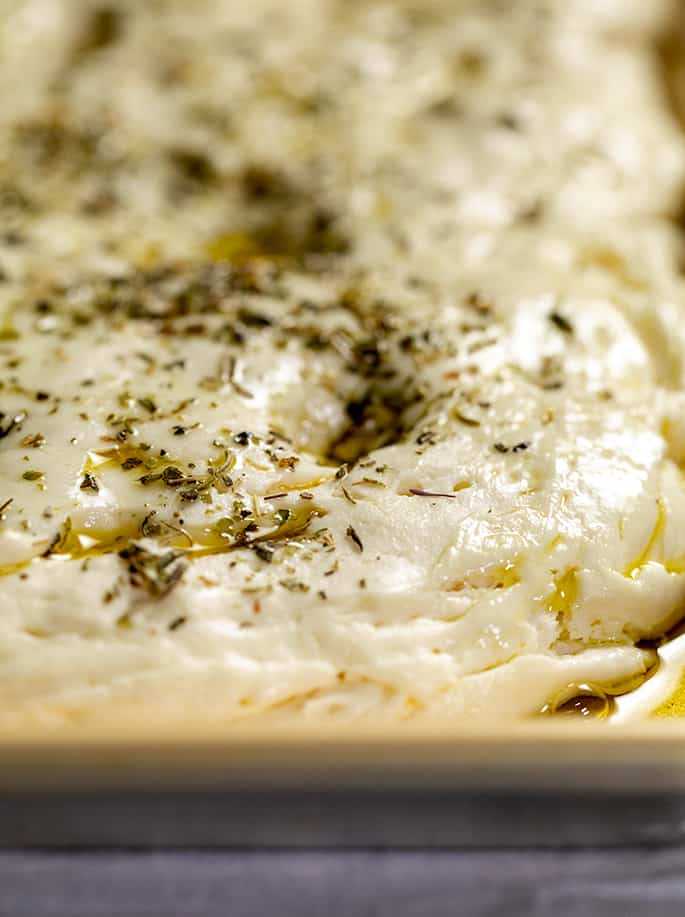
Time and patience are essential for making gf focaccia
Yeast is active at most common temperatures. It’s even active in the refrigerator. Just be sure the water isn’t evaporating in there!
Do not turn on your oven, turn it off, and then place your bread dough in there to rise. You very well might kill the yeast, and it’s an unnecessary risk.
For the starter, you need to just let it sit. It has a ton of water. It will rise.
For the first rise of the combined focaccia dough, in the refrigerator, the amount of rise is not what’s really important. Be sure you don’t lose any moisture by fastening a lid tightly, and just let it sit.
The refrigerator rise is for two things: yeasty flavor development, and absorption of the water into the flours. That allows us to have a higher hydration ratio without sopping wet dough.
For the second rise, you need an actual rise. So cover it, warm it a bit with some sort of ambient heat if you can, and let it be.
You want it to come as close as possible to doubling. It won’t rise much more in the oven. That rise is called “oven spring,” and this gluten free focaccia doesn’t have much oven spring.
You can turn on your oven to a low temperature (around 300°F) and place your rising dough on top of the range. Do not place it in the oven!
This second rise will take some time, and you want to let it rise until it’s dimpled on top. Typically, focaccia has a dimpled appearance since you poke it in places when raw to burst any enormous rising bubbles.
You just aren’t going to find those enormous bubbles here (although you might with the recipe in my Bakes Bread book made with my gluten free bread flour). But the dimples will happen naturally, as the dough rises unevenly.
What is that black thing in the video?
If you look carefully at the video, you might notice a very thin black disk that I place under the dough as it rises. It’s called the Raisenne Dough Riser, and it costs about $70 U.S.
I saw it online, and decided to test it (not sponsored; not affiliated) since it’s not crazy expensive, and the winter months can take a lot of extra patience as we wait for our yeast bread to rise. It isn’t hot to the touch, but it provides a consistent bump in temperature.
The Raisenne is, indeed, lovely for helping dough to rise in the colder, drier months. It’s not necessary, though! And it can be somewhat difficult to find in stock.
More tips for making the best gluten free focaccia
Here are some more tips to help you get perfect fluten free focaccia with every bake.
Use the freshest ingredients you can
Because this recipe has so few ingredients and each one plays a pivotal part, it’s so important that you use the best you can get your hands on.
This is especially true when it comes to the yeast and the olive oil. Both need to be fresh — your dough won’t rise if your yeast is bad, and you won’t much like the flavor of the bread if the olive oil is old and has gone off.
Play it safe with parchment paper
You’ll notice quickly that this gluten free Italian bread recipe produces more of a batter than your traditional dough. That’s because there’s no gluten to give the dough a squishy, moldable texture.
Because the gluten free focaccia dough is so sticky, there’s a chance it may stick to your pan. You can prevent this by thoroughly coating your sheet pan in oil before turning out the dough. You can also play it safe by adding a sheet of parchment paper.
Slice your gluten free focaccia with a pizza cutter
I’ve found that the easiest way to slice this gluten free bread is with a pizza cutter. The texture is similar to pizza dough, so a pizza cutter glides across it much easier than a knife.
How to store gf focaccia bread so it stays fresh
As with most gluten free breads, your focaccia is best eaten the same day that it’s made. After that, it tends to harden fairly quickly.
If you have don’t have a lot of leftovers, you can save your bread for the next day by tightly wrapping it and storing it in an airtight container on the counter.
If you don’t plan to eat your leftover focaccia bread in the next day, put it the fridge. When you’re ready to eat it, you can pop it in the oven, microwave, or toaster oven to soften it.
Can I freeze gluten free focaccia bread?
Yes, you can freeze gluten free focaccia, and I actually recommend that you do if you aren’t going to eat it in the next couple of days.
After it’s completed cooled, wrap it tightly in cling wrap or aluminum foil, and then place it inside a zip-top bag before freezing. The bread will last up to a month in the freezer.
The day before you want to have it, remove it from the freezer and allow it to defrost in the refrigerator. When it’s time to eat, heat the gluten free bread in the oven until it’s warmed through.
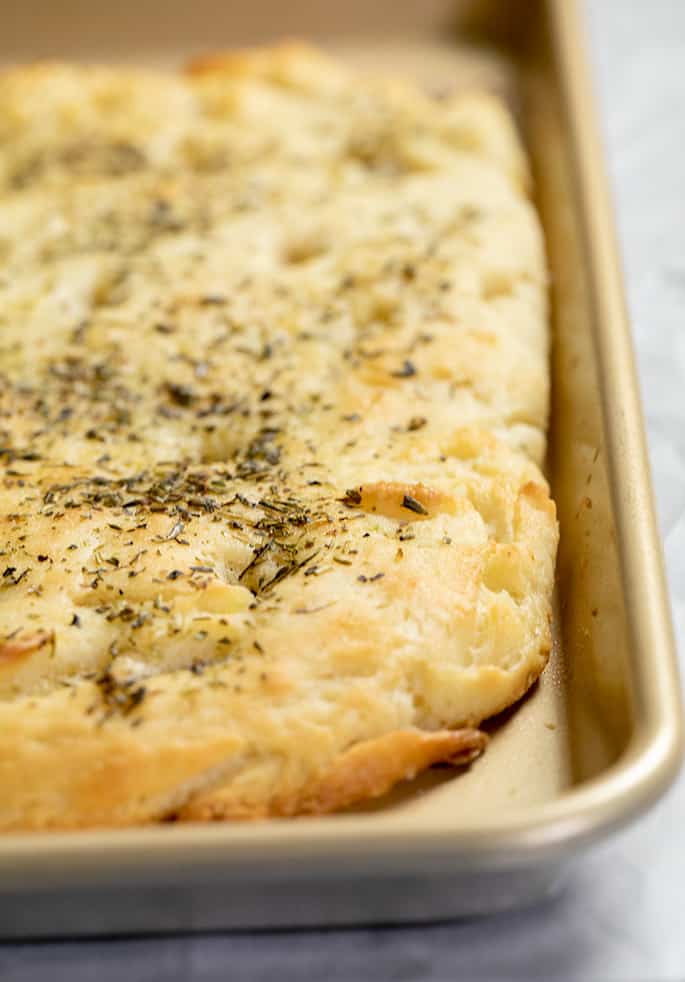
Substitution notes
Now, mostly, I’m going to tell you not to mess with perfection. But only because the recipe is extremely sensitive, and to get it to work, you’ve got to have the right ingredients in the right amounts added at the right time.
This is not a recipe to play with. The only exception is that you can switch the sweetener to make it vegan. Otherwise, please leave it alone. If this recipe doesn’t quite work with the ingredients you’ve got, then try one of our other bread recipes. There’s loads!
Gluten free, vegan focaccia
The recipe for gluten free herb focaccia is naturally dairy-free and egg-free. You can even make gluten free focaccia that’s also vegan if you replace the honey with maple syrup or even agave.
I recommend that you refrain from making any other substitutions, though. Its success relies upon the proper ingredients, in the proper proportions, in the manner described in the instructions.
Tapioca starch/flour
You must use tapioca starch/flour. You cannot use Expandex, which is a chemically modified tapioca starch/flour. They are not interchangeable.
If you don’t have tapioca starch/flour, order some. If you can’t have it, then I’m afraid this recipe isn’t going to work for you.
Instant yeast
There is no non-yeast substitute for yeast. But if you don’t have instant yeast (also called breadmaker or rapid-rise yeast), you can use active dry yeast.
To replace instant yeast with active dry yeast, multiply the amount (by weight) of the instant yeast (here, 6 grams) by 1.25 or 125{5676e3b156b07d12bd9df9fe13d641a85da396026abde11a1ff2d0afc1b3c015}. Here, that would mean 7.5 grams of yeast. Just add a bit more after you reach 7 grams.
Active dry yeast has a thicker coating around the yeast, so you should soak it in some liquid in the recipe (here, water) until it foams before adding it with the rest of the water.
Herbs and toppings
This gluten free focaccia bread is so versatile when it comes to toppings. I love using dried herbs de Provence, but you can play around a bit to find your favorites.
- Make a simple gluten free rosemary bread by topping your focaccia with dried or fresh rosemary, olive oil, and flaky sea salt
- Add savory elements to your gluten free Italian bread with sliced onions, sun-dried tomatoes, and roasted red peppers
- Experiment with different herbs — dried rosemary, thyme, basil, and oregano pair beautifully with this gf focaccia bread.

FAQs
Is focaccia bread gluten free?
No, traditional focaccia bread is not gluten free because it’s made using wheat flour.
Is yeast gluten free?
Yes, most yeast is naturally gluten free. However, you always want to double-check product labels as some manufacturers made sneak in anti-caking ingredients that contain wheat.
What is gluten free focaccia bread like?
Gluten free focaccia is similar to pizza crust in that it’s made using many of the same ingredients and it’s flat.
However, because focaccia bread contains more yeast, it bakes up to have a fluffier interior.
As the outside is doused with plenty of olive oil, it gets irresistibly crispy, while the inside stays soft and airy.
How do you serve gluten free focaccia?
Honestly, you can eat gluten free focaccia bread as-is, right from the pan, as it’s quite flavorful.
You can also serve with a dipping oil or sauce, such as marinara, if you’re having it as a snack, or serve it as a side next to pasta, pot roast, and more.
Gluten free focaccia also serves as a lovely pizza crust. Just add your toppings and bake until your cheese is melted. Or you can slice it like sandwich bread and fill it with cheese and cold cuts.
What’s the best flour for focaccia bread?
For this easy gluten free focaccia recipe, you need to use Better Batter and tapioca flour. There are no substitutes for either, so put away the gluten free bread flour and reach for these instead.
What should focaccia dough look like?
Though we call it a dough because we’re baking bread, it would be easier to call the unbaked form a gluten free focaccia batter. That’s because it’s very sticky, wet, and shapeless — it’s nothing like traditional, wheat-based doughs.
Do I need to knead gluten free focaccia?
And because our gluten free focaccia isn’t like “normal” bread, there’s no need to knead the dough! In fact, kneading this bread dough is not possible.
Instead, as instructed in the recipe below, please simply mix the ingredients as I specify, allow for rise time, mix the starter and then the dough, place it in a sealed proofing container, let it sit in the fridge for up to 12 hours, and then prepare it for baking.
Why isn’t my gluten free focaccia not fluffy on the inside?
If your gluten free focaccia has come out dense rather than light and fluffy, you likely had a problem with your rise. It could be that your yeast was bad, the yeast didn’t have enough “food” to rise, the proofing container you used wasn’t properly sealed causing it to lose moisture, or the dough simply didn’t have enough time to rise properly.
Gluten Free Focaccia Bread | with herbs
Try this gluten free focaccia bread recipe to pair with pasta or eat on its own. This gf Italian herb bread has a crispy, flavorful outside and soft, fluffy inside.
Yield: 6 servings
Prevent your screen from going dark
Equipment
-
Large lidded bucket for proofing
-
Jelly roll pan (10-inches x 15-inches x 1-inch)
Ingredients
For the dough
- 1 ¾ cups (245 g) all purpose gluten free flour blend (Better Batter or mock Better Batter is best) (See Recipe Notes)
- ¾ teaspoon xanthan gum (omit if your blend already contains it)
- ⅜ cup (48 g) tapioca starch/flour (See Recipe Notes)
- 1 teaspoon (6 g) kosher salt
- 1 tablespoon (12 g) granulated sugar
- Risen starter
- 3 tablespoons (42 g) extra virgin olive oil (See Recipe Notes)
For the topping
- ¼ cup (56 g) extra virgin olive oil
- 2 tablespoons dried herbs de Provence (or your favorite savory dried herbs)
Instructions
Make the starter.
-
Place all the starter ingredients in a medium-size bowl, and whisk until well-combined. The mixture will be thick and shapeless.
-
Cover the bowl with plastic wrap, and set it aside in a warm, draft-free location to rise until at least doubled in size.
-
This will take about an hour in a relatively warm environment, but could take much longer in a cold, dry kitchen.
Make the dough.
-
Once the starter has finished rising, in the bowl of a stand mixer fitted with the paddle attachment or a large bowl with a heavy-duty handheld mixer, place the flour, xanthan gum, tapioca starch/flour, salt, and sugar, and whisk to combine well.
-
Add the risen starter and the 3 tablespoons olive oil and mix on low speed until combined.
-
Raise the mixer speed to medium-high and mix until the dough begins to take on a whipped appearance (about 3 minutes).
For the cold rise.
-
Transfer the dough to a lightly oiled proofing bucket or bowl with a lid that’s large enough for the dough to double (although it won’t likely double).
-
Cover the bowl or bucket tightly with the lid (if you don’t have a lid make sure you cover it very well with plastic wrap) and place it in the refrigerator for at least 12 hours and up to 3 days.
Shape and top the dough.
-
On baking day, begin with a rimmed baking sheet that’s about jelly roll pan size (10-inches x 15-inches). A half baking sheet (13-inches x 18-inches) is fine, too.
-
Drizzle about 2 tablespoons of the olive oil from the topping on the bottom of the baking sheet, and spread it evenly around the surface of the pan.
-
Remove the prepared dough from the refrigerator and turn it out onto the oiled baking sheet.
-
Drizzle the top and your clean hands lightly with a bit more oil, and, with the tips of your fingers, press and push the dough into a rectangle about 9-inches x 13-inches.
-
The dough will be very sticky and difficult to handle. Persist with a light touch.
-
Using an oiled rolling pin, an oiled bench scraper, or an oiled cake turner, smooth the top of the rectangle as much as you can.
-
Sprinkle the top of the dough evenly with the dried herbs. Drizzle evenly with the remaining olive oil, brushing it very gently with a pastry brush to distribute the oil evenly.
Bake the bread.
-
When the dough is nearly at the end of its rise, preheat your oven to 400°F.
-
Uncover the risen dough, drizzle lightly with more olive oil if you like, and place in the center of the preheated oven. Bake for 15 minutes.
-
Reduce the oven temp to 375°F and bake until most of the oil has been absorbed by the bread, the top is lightly golden brown, the bread is firm to the touch, and the internal temperature with an instant-read thermometer in the center reads at least 200°F (another 10 to 15 minutes).
-
Remove the pan from the oven, and immediately transfer the bread to a wire rack to cool as long as you can stand it. Slice and serve warm.
Notes
Please click the link for the all purpose gluten free flour blends page. The flour blend you choose is always important, but here I really can only promise results if you use either Better Batter (original blend) or my mock Better Batter.
You must use tapioca starch/flour. There is no substitute.
For the oil.
We use a ton of extra virgin olive oil in this recipe. Make sure you use an oil you really like the smell and taste of.
If you would like to use a different oil, use something with flavor that you like. A neutral cooking oil will crisp the bread, but not add flavor. That will make the bread seem almost a bit oily, even though it really isn’t.
Originally published on the blog in 2021; in 2023, text resources added.
Gluten Free Focaccia Bread | with herbs
Try this gluten free focaccia bread recipe to pair with pasta or eat on its own. This gf Italian herb bread has a crispy, flavorful outside and soft, fluffy inside.
Yield: 6 servings
Prevent your screen from going dark
Equipment
-
Large lidded bucket for proofing
-
Jelly roll pan (10-inches x 15-inches x 1-inch)
Ingredients
For the dough
- 1 ¾ cups (245 g) all purpose gluten free flour blend (Better Batter or mock Better Batter is best) (See Recipe Notes)
- ¾ teaspoon xanthan gum (omit if your blend already contains it)
- ⅜ cup (48 g) tapioca starch/flour (See Recipe Notes)
- 1 teaspoon (6 g) kosher salt
- 1 tablespoon (12 g) granulated sugar
- Risen starter
- 3 tablespoons (42 g) extra virgin olive oil (See Recipe Notes)
For the topping
- ¼ cup (56 g) extra virgin olive oil
- 2 tablespoons dried herbs de Provence (or your favorite savory dried herbs)
Instructions
Make the starter.
-
Place all the starter ingredients in a medium-size bowl, and whisk until well-combined. The mixture will be thick and shapeless.
-
Cover the bowl with plastic wrap, and set it aside in a warm, draft-free location to rise until at least doubled in size.
-
This will take about an hour in a relatively warm environment, but could take much longer in a cold, dry kitchen.
Make the dough.
-
Once the starter has finished rising, in the bowl of a stand mixer fitted with the paddle attachment or a large bowl with a heavy-duty handheld mixer, place the flour, xanthan gum, tapioca starch/flour, salt, and sugar, and whisk to combine well.
-
Add the risen starter and the 3 tablespoons olive oil and mix on low speed until combined.
-
Raise the mixer speed to medium-high and mix until the dough begins to take on a whipped appearance (about 3 minutes).
For the cold rise.
-
Transfer the dough to a lightly oiled proofing bucket or bowl with a lid that’s large enough for the dough to double (although it won’t likely double).
-
Cover the bowl or bucket tightly with the lid (if you don’t have a lid make sure you cover it very well with plastic wrap) and place it in the refrigerator for at least 12 hours and up to 3 days.
Shape and top the dough.
-
On baking day, begin with a rimmed baking sheet that’s about jelly roll pan size (10-inches x 15-inches). A half baking sheet (13-inches x 18-inches) is fine, too.
-
Drizzle about 2 tablespoons of the olive oil from the topping on the bottom of the baking sheet, and spread it evenly around the surface of the pan.
-
Remove the prepared dough from the refrigerator and turn it out onto the oiled baking sheet.
-
Drizzle the top and your clean hands lightly with a bit more oil, and, with the tips of your fingers, press and push the dough into a rectangle about 9-inches x 13-inches.
-
The dough will be very sticky and difficult to handle. Persist with a light touch.
-
Using an oiled rolling pin, an oiled bench scraper, or an oiled cake turner, smooth the top of the rectangle as much as you can.
-
Sprinkle the top of the dough evenly with the dried herbs. Drizzle evenly with the remaining olive oil, brushing it very gently with a pastry brush to distribute the oil evenly.
Bake the bread.
-
When the dough is nearly at the end of its rise, preheat your oven to 400°F.
-
Uncover the risen dough, drizzle lightly with more olive oil if you like, and place in the center of the preheated oven. Bake for 15 minutes.
-
Reduce the oven temp to 375°F and bake until most of the oil has been absorbed by the bread, the top is lightly golden brown, the bread is firm to the touch, and the internal temperature with an instant-read thermometer in the center reads at least 200°F (another 10 to 15 minutes).
-
Remove the pan from the oven, and immediately transfer the bread to a wire rack to cool as long as you can stand it. Slice and serve warm.
Notes
Please click the link for the all purpose gluten free flour blends page. The flour blend you choose is always important, but here I really can only promise results if you use either Better Batter (original blend) or my mock Better Batter.
You must use tapioca starch/flour. There is no substitute.
For the oil.
We use a ton of extra virgin olive oil in this recipe. Make sure you use an oil you really like the smell and taste of.
If you would like to use a different oil, use something with flavor that you like. A neutral cooking oil will crisp the bread, but not add flavor. That will make the bread seem almost a bit oily, even though it really isn’t.
Originally published on the blog in 2021; in 2023, text resources added.
